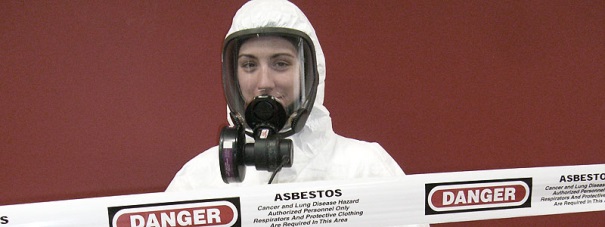Where is Asbestos Found?
 Below is a list of asbestos containing building and industrial products. This list is by no means exhaustive:
Below is a list of asbestos containing building and industrial products. This list is by no means exhaustive:
Flooring Systems: paper backed sheet vinyl, sheet, vinyl tile, construction paper and asphaltic floor planking.
Wall & Ceilings: gypsum board filling compound, stippled and smooth plaster, spray applied texture coat (popcorn ceilings), cementitious wall-board, mill board, acoustic ceiling tiles, and acoustic spray applications.
Mechanical/Electric: preformed pipe and tank insulation, insulating cement, jacketing material, duct tape and sealant, gasket and packing material, through penetration fire-stop grout, paper insulation within incandescent light fixtures, electrical wire insulation, arc shields.
Roofing Systems paper, felt, and asphaltic mastic.
Miscellaneous: rain water leader (drain pipe), underground piping, adhesives, caulking, sealants, window putty, mortars, grouts, laboratory fume hoods and countertops, exterior siding, welding gloves, ironing board pads, automotive break pads and clutch facings.
Asbestos abatement projects should only be performed by trained professionals who have the specialized equipment and experience to ensure worker, and building occupant safety by complying with the strict regulations, guidelines, and procedures established by the regulatory agencies.
Visit our Member Contractor section to find a professional hazardous materials abatement company for your project.
About Asbestos
Asbestos is a natural, fibrous mineral. Asbestos fibres are generally incombustible, have high tensile strength, and have outstanding thermal, acoustical, and electrical insulating properties. As a result of these unique chemical and physical properties, asbestos became a useful ingredient in numerous commercial and industrial products.
The most common type of asbestos is chrysotile, known as white asbestos, and accounts for approximately 90% of worldwide production and use.
Asbestos in Building Construction
By 1969, thousands of asbestos containing materials were being manufactured and their presence on a building construction site was as common as gypsum board or plywood are today. Asbestos fibrated construction materials became the industry standard, and were used in a multitude of building construction and industrial applications particularly where durability and/or fire resistance was required. It has been estimated that asbestos has been used in over three thousand applications and products.
Why Is Exposure to Asbestos Dangerous?
Asbestos fibres can divide both horizontally and longitudinally many times and ultimately end up as microscopic fibrils that are invisible to the naked eye.
These microscopic fibers are extremely aerodynamic and can remain airborne for extended periods of time, hours or even days. Serious respiratory diseases such as asbestosis, lung cancer, and mesothelioma have been associated with inhalation of asbestos fibres.
A latency period of between 10 and 25 years is common between initial exposure and recognizable symptoms of asbestos related disease. There are three main diseases associated with the inhalation of asbestos fibres are Asbestosis, Lung Cancer and Mesothelioma.
However, the mere presence of asbestos in a building does not necessarily mean that the health of the occupants is endangered. As long as asbestos containing materials remain in good condition, and are not disturbed, exposure to airborne asbestos fibres is unlikely.
Asbestos building products can become hazardous if they have the potential to becoming airborne due to natural deterioration, damage, or physical disturbance. Routine maintenance, housekeeping activities, renovations, and demolitions all have the potential of causing asbestos fibres to become airborne, unless strict asbestos abatement procedures are utilized.

